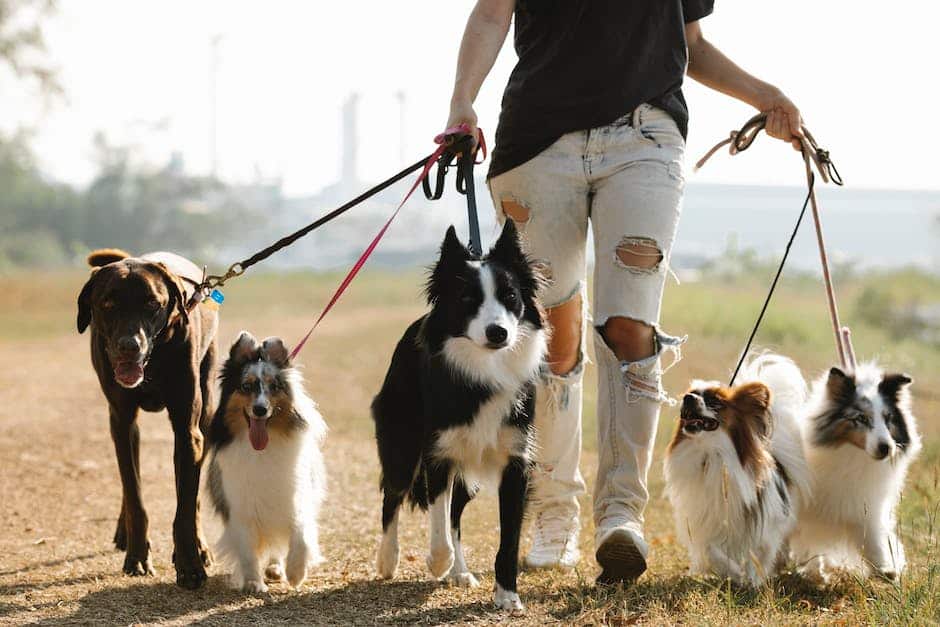
For many, the joy of dog ownership comes with an unwelcome companion: allergies. These allergic reactions are more than mere annoyances—they can significantly impact the quality of life. Yet, what exactly triggers these symptoms? Within the intricate web of our immune system lies the answer, as it mistakenly identifies harmless proteins found in dog dander, saliva, and urine as threats, leading to the array of symptoms dog allergy sufferers know all too well.
As we navigate through the complexities of dog allergens and the varying degrees to which individuals may be affected, it’s essential to demystify the science behind these reactions and to explore the notion of ‘hypoallergenic’ breeds. By gaining a foundational understanding of these elements, we can better approach effective management techniques and lifestyle strategies that can offer relief and forge a more harmonious bond with our four-legged friends.
Understanding Dog Allergies
Unraveling the Mystery: What Triggers Dog Allergies in Humans
When it comes to the love of dogs, sometimes our own bodies don’t seem to be on the same page. For many individuals, the presence of a furry companion can trigger an onslaught of sneezing, watery eyes, and a host of other uncomfortable symptoms. But what exactly is it about dogs that set off these allergic reactions in humans? Let’s delve into the crux of what triggers dog allergies, making this seemingly perplexing situation a little more understandable.
The Culprit: Dog Allergens Explained
The main instigators of dog-related allergies are proteins found in a dog’s dander (skin flakes), saliva, and urine. Contrary to common belief, it’s not the dog’s hair that directly triggers allergies, but rather the proteins that cling to the hair. These microscopic allergens can become airborne when a dog shakes, scratches, or moves about, finding their way onto human mucous membranes and kicking the immune system into an overreactive mode.
Dander: More Than Just Flakes
Dander is much more than just the visible shedding of a dog’s skin and fur. These tiny, even microscopic, flakes of skin carry the proteins that are so problematic for allergy sufferers. Dander can also latch onto clothing, furniture, and other surfaces, making it a persistent presence in a pet owner’s environment.
A Slobbery Situation: Saliva’s Role
When a dog licks itself clean, the saliva dries and leaves behind the allergy-causing proteins. When a dog then rubs against your skin or licks your face, the same proteins can trigger an allergic response. Even without direct contact, saliva can transfer onto surfaces or become airborne as the moisture evaporates.
The Unseen Trigger: Urine
While not as often talked about as dander or saliva, urine can also be a source of allergens. Although typically less of a concern due to more discrete and controlled circumstances, dried urine particles can still contribute to air-bound allergens in a home.
Managing the Allergen Avalanche
Understanding the allergen suspects is a great start, but managing their impact makes all the difference for allergy sufferers. Regular cleaning and grooming of your dog, along with strategic use of air filters, can help control the spread of allergens in your living space. Vacuuming and dusting become key players in the effort to create an allergen-reduced environment.
Furthermore, while no dog breed is truly hypoallergenic, some breeds produce fewer allergens, which may be something to consider when picking a pet for an allergy-prone individual. Personal hygiene, including frequent hand-washing after petting a dog, can also significantly reduce the chances of experiencing an allergic reaction.
In the end, knowledge is the first line of defense. By being aware of what specifically triggers dog allergies in humans, it’s possible for pet lovers to still enjoy the company of their canine companions while keeping allergic reactions at bay. While it may require a bit of extra effort and planning, the joy of dog ownership can still be a part of even an allergy sufferer’s life with the right strategies in place.
Dog Breeds and Allergen Levels
Understanding the Allergenicity of Different Dog Breeds
When it comes to living with dogs, allergy sufferers often face the challenge of finding a furry friend that won’t leave them in a constant battle with sneezes, sniffles, and itchy eyes. While many may think the search for a hypoallergenic dog breed is like finding a needle in a haystack, there is hope. Certain dog breeds have characteristics that make them better suited for those with allergies.
The Myth of Completely Hypoallergenic Dogs
Firstly, it’s important to clarify one common misconception: no dog breed is completely hypoallergenic. However, some breeds are known to be more tolerable for allergy sufferers due to their particular type of coat, the amount they shed, and the amount of allergens they produce.
Breeds with Non-Shedding Coats
One factor to consider is the type of coat a dog has. Breeds with continuously growing hair rather than fur, resembling human hair, tend to shed less. This minimizes the amount of dander that accumulates around the home. Examples of these breeds include Poodles and Bichon Frises, both celebrated for having coats more compatible with allergic owners.
Single-Coated Breeds
Dogs with single coats, which lack a dense undercoat, tend to release less dander into the environment. Breeds such as the Maltese and the Basenji fall into this category and are often recommended for those wary of allergies. Thanks to their single layer of fur, they contribute less to airborne allergens that are likely to trigger allergic reactions.
Size Matters
It’s also worth noting that the size of the dog can impact the degree of allergens present. Smaller breeds, simply by virtue of their diminutive stature, can have a smaller overall impact on allergen accumulation. Breeds like Shih Tzus and Yorkshire Terriers are not just lap-sized companions; their small bodies mean less skin-producing allergens and less fur spread around the living spaces.
Regular Grooming: A Helping Hand
Regardless of breed, one critical component in managing allergies is regular grooming. By keeping any dog well-groomed and clean, the amount of dander and saliva residue on their coat can be drastically reduced. Scheduling regular baths and brushing sessions helps capture those allergens before they spread throughout the home.
Choosing the Right Breed
For those aspiring to be dog owners despite allergies, spending time with various breeds can offer a personal gauge of allergenic response. It’s essential to visit breeders or shelters and have direct contact with the dogs. Allergies can vary significantly from person to person, so it’s important to find the specific dog breed that suits an individual’s tolerance levels.
Air Purifiers, Vacuuming, and Allergen-Free Zones
In conjunction with selecting an allergy-friendly breed, creating an environment that minimizes allergen presence is crucial. Utilizing air purifiers with HEPA filters, vacuuming regularly with a strong suction and HEPA filter, and establishing allergen-free zones, particularly the allergy sufferer’s bedroom, can create a more agreeable environment.
By understanding the factors that contribute to a dog’s allergenic potential, finding a breed that aligns with one’s allergy concerns, and maintaining rigorous cleanliness protocols, allergy sufferers can find solace in the fact that dog ownership is indeed within reach. With this thoughtful approach, the companionship of a loyal canine needn’t be foregone due to allergies.

Allergy Management Techniques
Managing Dog Allergies: Strategies to Keep You and Your Furry Friend Happy
For all the joy dogs bring to our lives, there’s no denying that for some, the sneezing, itchy eyes, and runny nose associated with dog allergies can dampen that happiness. The good news is, that managing dog allergies is possible, and with a few savvy strategies, both you and your dog can live together in harmony.
Allergies can feel like an invisible hurdle, but by adopting a few clever tactics, you can clear the air—quite literally. Let’s dive into the approach you can take to minimize allergens and maximize comfort.
Understanding Your Allergy Triggers
Before you can tackle dog allergies, understanding what triggers your reaction is vital. Allergens are sneaky and can cling to clothing, and furniture, and even circulate through the air. Knowing this, one of the first steps toward managing dog allergies is reducing your exposure.
Regular Cleaning Regimen
Maintaining a rigorous and regular cleaning schedule is key. Frequent vacuuming with a HEPA filter can help capture the microscopic dander that traditional vacuums might miss. Additionally, steam cleaning carpets and upholstery can help reduce the presence of allergens that are eagerly awaiting to trigger your symptoms.
Washable Throws and Dog Beds
Setting up designated areas for your dog with washable throws and beds can localize where dander accumulates. Be sure to wash these frequently in hot water to kill any clingy allergens. Keep your furry friend’s favorite spots easy to clean—sustainability is the name of the game here.
Air Filtration Systems
Don’t underestimate the power of a good air filtration system. Air purifiers with HEPA filters can be a godsend, trapping allergens and keeping the air in your living space much cleaner. Pet-specific air purifiers are now a thing, so consider investing in one to really tailor to your needs.
Personal Allergen Management
Personal allergen management is as crucial as managing your environment. Changing clothes after prolonged dog cuddling sessions can drastically reduce the spread of allergens throughout your home. Take it a step further by keeping certain clothes ‘dog-free’. For some, a quick shower might be necessary to rinse away any potential allergens.
Strategic Dog Care
Beyond the living space, how you care for your dog can also affect allergy levels. Regular bathing can reduce the amount of allergens on your dog’s coat. Just be cautious to not over-bathe, as this can dry out their skin and actually increase dander production.
Fish Oil Supplements
Interestingly, certain supplements like fish oil can contribute to a healthier coat for your dog and potentially reduce shedding and dander. Consult your vet for advice on the best dietary additions for your dog’s specific needs.
Medication and Treatment
Don’t shy away from medical assistance. Over-the-counter antihistamines can relieve symptoms for many people. For those with more severe allergies, it’s worth discussing the issue with your doctor. They might recommend allergy shots, which gradually desensitize your body to the allergens.
Attention to Details
Seemingly small details can make a big difference in managing your allergies. Implementing a no-dog policy in certain areas, such as the bedroom, creates an allergen-free sanctuary where your immune system can take a breather. Ensuring that your dog’s toys and accessories are also regularly washed can cut down on hidden allergen reservoirs.
There’s a wealth of strategies out there to manage dog allergies effectively, and each person’s situation is unique. An approach combining environmental management, personal care, strategic dog grooming, and medical advice can pave the way to a more harmonious living situation with your beloved pet. By staying on top of these methods, you can maintain a loving and comfortable home environment for both you and your canine companion, without letting allergies stand in the way.

Alternative Therapies and Lifestyle Changes
Exploring Innovative Solutions for Dog Allergies: Beyond Traditional Methods
Navigating the world of dog allergies can be like navigating a winding trail with your furry friend—full of unexpected twists and turns. You’re already aware that dander, saliva, and urine are the usual suspects when it comes to triggering those pesky allergic reactions. And by now, you’ve got a routine down for keeping your living space as allergen-free as possible, and you’ve done your homework on breeds that might be easier on your allergies. You’ve swept, cleaned, and purified the air, but what non-traditional methods are out there that might lend a helping paw in your quest for a sniffle-free life with your beloved dog?
Revolutionizing the Battle Against Dog Allergens: Probiotics for Pooches
The power of probiotics has been a hot topic in human health for quite a while, busting onto the scene with promises of better digestion and stronger immune systems. But did you know that these beneficial bacteria can also wave a magic wand over the realm of canine-caused sniffles and sneezes? That’s right, certain probiotic strains specifically developed for dogs could potentially reduce the allergenic quality of their dander. By enhancing your dog’s gut health, you’re not only boosting their well-being but could also help in decreasing the severity of your allergic reactions.
Diving Into Dietary Adjustments: Omega-3s and Novel Proteins
It’s no secret that a balanced diet can make a world of difference in anyone’s health. For dogs, incorporating omega-3 fatty acids into their meals isn’t just about shiny coats and healthy joints—it may also help manage the allergenic substances found in their saliva and dander. But let’s take the trail less traveled and consider novel protein diets. These are diets featuring protein sources that your dog has never eaten before. Why is this important? It minimizes the risk of adverse food reactions that can sometimes exacerbate skin conditions, leading to more dander production. How’s that for a fresh take on the dinner menu?
Embrace the Cutting Edge: Innovative Allergy Shots (Immunotherapy)
Traditional allergy shots have been a go-to for many human allergy sufferers, and now dogs are joining the party with tailor-made immunotherapy. How does it work? By introducing minuscule amounts of common dog allergens into your system, your body can potentially build up a tolerance, thus reducing the allergic reactions over time. It’s like slowly acclimatizing your immune system to the furry friend alongside you at home. Remember, it’s crucial to discuss this option with an allergist familiar with the innovative approach to ensure it aligns with your health needs.
Strengthening the Canine-Human Bond with Lifestyle Choices
Part of living with allergies is adapting your lifestyle to foster a comfortable environment. Beyond the confines of cleaning and hypoallergenic dog breeds, it’s essential to lead a lifestyle that inherently bolsters your body’s defenses against allergens. Regular exercise, staying hydrated, and a wholesome diet are the keystones to fortifying your immune system. When your health and stamina are at their peak, the impact of allergens can retreat to the background, like a distant bark in the night.
The Green Oasis: Houseplants for Purifying Your Home
Picture this—the quiet serenity of green space within your home where the air is just… cleaner. Certain houseplants are nature’s air purifiers, grabbing hold of unseen allergens and filtering them out with a whisper. From peace lilies to spider plants, these green guardians can serve as an aesthetically pleasing line of defense in the fight against allergens. Though not the first thought when considering dog allergies, it’s a path worth exploring for those wanting to merge a love for plants with the need for a clearer breathing space.
In the world of dog lovers with allergies, every new strategy brings with it a ray of hope. As we blaze this trail together, keep an open mind to the possibilities that science and lifestyle tweaks bring. And who knows? With some unconventional steps and a dash of dedication, you and your dog might just find that blissful balance that allows for a life full of tail wags and worry-free hugs.

Embarking on a journey to alleviate dog allergies can be as challenging as it is rewarding. Deliberate and informed changes in how we interact with our pets, the choices we make regarding their care, and the modifications we apply to our living environments can all contribute to a higher quality of life for those affected. Through a blend of traditional methods and innovative approaches to allergy management, individuals can find a tailored pathway to coexist more comfortably with their beloved canines. As each person’s experience with allergies is unique, so too should be the strategies deployed in mitigating them. Armed with knowledge and a willingness to adapt, dog allergy sufferers have the power to reclaim the joy and companionship that dogs add to our lives, transforming the battle with allergens into a tale of triumph over adversity.





